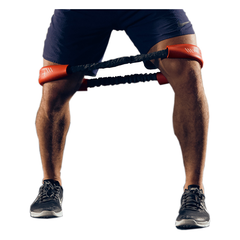Strength athletes have long feared aerobic exercise as a hindrance to their gains.
Unfortunately, this is proven valid for the very practical reasons that logging a bunch of miles makes you tired and takes time away from pushing weights.
However, it gets even more intricate with evidence suggesting that endurance work may interfere with the molecular pathways that drive muscle growth, known as the interference effect.
Therefore, avoiding long endurance activities is reasonable if you compete in a barbell sport or if your only joy in life hinges on how much you can lift. I recall a prominent powerlifter saying it was time to do some cardio if you got out of breath walking from the car to the gym door.
But for the bulk of us, we need an engine.
Most sports require sustained effort over an hour, and you can't be pooped after only 30 minutes if you want to enjoy an active lifestyle. Or even the buffest will sometimes find the itch to enter some type of endurance event.
The good news is that the interference effect may not be as prominent as we once suspected. And although it's challenging to chase two rabbits, it seems possible to maintain, or even build, your hard-earned strength while improving your cardiovascular fitness.
For one example, this guy logged a 3-hour marathon and is on track to deadlift 500 lbs, squat 400 lbs, and bench 300 lbs.
However, you do need some strategy for it to work. Here are some rules to follow if you've got your eyes set on building your aerobic fitness but are afraid of losing strength.
The Magic Dose for Cardio & Lifting
If you've got your sights on an endurance goal, such as a race, the bulk of your focus should be on your endurance training. But obviously you'll need to work weights into the schedule to keep your strength, while ensuring it doesn't interfere with the aerobic training you've prioritized.
The good news is that strength improvements are readily seen without a ton of work, as long as the intensity is high enough to elicit those adaptions.
Therefore for purely strength numbers, stick with the compound lifts, and drop the volume to only 2-4 sets of 4-6 reps. The reps should be heavy, but avoid going to your max effort on more than one set.
Doing this for your key lifts two days per week should be enough to maintain the barbell lifts, but it's also manageable so you're not excessively sore the next day.
Although, you'll need a bit more volume if you want to elicit some muscle growth. So if it's size you're after, then tack on 2-3 sets to failure for 2-3 exercise at then end of your training.
Then of course, one of the Crossover Symmetry Strength Programs for your finisher.
Check out our blog on How to Gain Muscle for a more complete picture.
Pro Tip-
The key to pursuing both strength and endurance gains is training smarter and not harder.
Find a strength program with a clear linear progression.
The 5-3-1 Program by Jim Wendler is an excellent option for lower-volume strength training that's proven to add weight to your max lifts. It's a simple template that follows a monthly progression for the squat, deadlift, press, and bench press. Plus, there are several options to add if you're also interested in hypertrophy work.
Or, Run Strong by Crossover Symmetry has both power and accessory work designed specifically to make you a better runner.
Timing Your Lifts & Cardio for Maximum Gains
Getting in a lift after logging some miles is probably the most practical option, but this is also when the interference effect would be at its greatest.
It's recommended that the two activities be spaced by at least 3 hours, but 6hrs or longer is better to limit any potential interference between the two training sessions.
Not only does spacing out your workouts allow the body to prioritize the specific adaptations needed for each type of exercise, but it also allows for adequate recovery and replenishment of energy stores.
Pro Tip-
Some recommendations push for 24hrs between aerobic and resistance training, but this is problematic for managing the recovery schedule.
With key tempo and threshold runs during the week and a long run on the weekend, trying to add two more days exclusively for heavy lower-body lifting leaves little downtime for the legs.
Therefore, I opt for two mega training days, where I do a harder run in the morning and a lower body lift in the evening. This schedule gives me more complete recovery days for the legs.
What Type of Cardio is Best?
Of course, if you're preparing for a specific event, you'll need to train for that sport. But if you're only concerned with building cardiovascular fitness, then running long slow miles will have the most significant impact on your strength.
Doing aerobic intervals where you push your body close to max effort followed by a full recovery helps build aerobic fitness while emphasizing the fast twitch muscles needed for strength.
Nor does it have to be the traditional aerobic movements if you've got a focus on general capacity. For example, sled pushes, and extended circuits using body-weight exercises like lunges and squats may enhance muscle growth while building your ability to go longer.
Or, studies show that quadricep growth is promoted by cycling immediately after lifting, so that may be a better option for your cardio if you've got quad goals
Pro Tip-
I've found the Power Zone Endurance classes on the Peloton Bike are the perfect cross training for runners. It's the right blend of lower threshold endurance work with some power mixed in. Take anything led by Matt Wilpers and you're in good hands.
Nutrition
If there is one thing cardio is known for, it's burning calories, which is also what the body needs for muscle growth. So if you're gaming on cutting calories during this hybrid aerobic and resistance program, you will fail on both fronts.
Starting with protein—you'll need a good amount.
The recommendations are all over the place, but the most consistent advice for an aerobic athlete is 1g of protein per 1lb of body weight.
This ensures that you've got all the necessary building blocks.
Additionally, getting enough carbohydrates will ensure you have the fuel stores to power through your long-distance work without breaking into the protein stores needed to fuel muscle repair and growth.
The importance of the nutrient timing around all of this has been called into question as of late with people debunking the magic window.
However, it's best to leave nothing up to chance, and if you don't get on nutrition quickly, it tends to get away. Therefore, finish your workouts with carbs and proteins to ensure you're recovered and ready for the next training session.
Pro Tip-
At this point supplements aren't a Pro Tip, but I'll go ahead and say it if you're struggling to get enough protein into your diet. I even broadly classify supplements as things I take purely for the nutrition gain.
Egg whites from a carton, shakes, cottage cheese, turkey jerky sticks, are all helpful foods to have on hand to hit your goals.
I'll secretly admit I regularly take Branch Chain Amino Acids as well. Many fitness nerds called out BCAAs recently for having limiting supporting research. Still, I like the taste, and it adds to the overall amino acid pool—specifically, leucine, an anabolic stimulus.
If anything it gets me to drink 32oz of water in the morning before I kick back my coffee.
But ultimately, find what works for you.
Train Smart
In conclusion, the fear that aerobic exercise hinders strength gains in strength athletes is valid to some extent. Endurance work can make you tired and take away time from weightlifting.
While there is evidence of the interference effect, it's likely not be as prominent as once believed. You might need to accept some loss in strength if you're going to be extreme, but overall the right approach and consistent effort in the gym will keep you strong while you build your aerobic base.
 Shoulder Packages
Shoulder Packages
 Hip & Core Package
Hip & Core Package
 Bundles
Bundles
 Accessories
Accessories


















